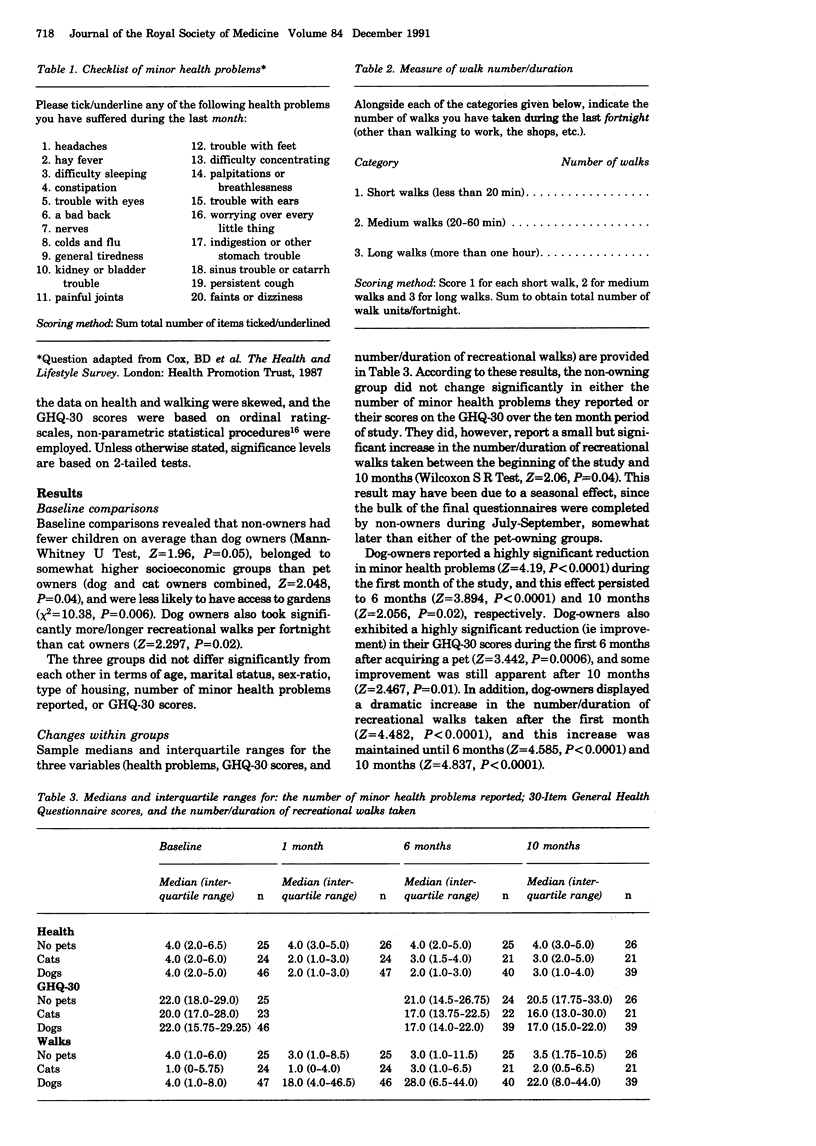Abstract
A 10-month prospective study was carried out which examined changes in behaviour and health status in 71 adult subjects following the acquisition of a new pet (either dogs or cats). A group of 26 subjects without pets served as a comparison over the same period. Both pet-owning groups reported a highly significant reduction in minor health problems during the first month following pet acquisition, and this effect was sustained in dog owners through to 10 months. The pet-acquiring groups also showed improvements in their scores on the 30-item General Health Questionnaire over the first 6 months and, in dog owners, this improvement was maintained until 10 months. In addition, dog owners took considerably more physical exercise while walking their dogs than the other two groups, and this effect continued throughout the period of study. The group without pets exhibited no statistically significant changes in health or behaviour, apart from a small increase in recreational walking. The results provide evidence that pet acquisition may have positive effects on human health and behaviour, and that in some cases these effects are relatively long term.
Full text
PDF



Selected References
These references are in PubMed. This may not be the complete list of references from this article.
- Baxter D. N., Leck I. The deleterious effects of dogs on human health: 2. Canine zoonoses. Community Med. 1984 Aug;6(3):185–197. doi: 10.1093/oxfordjournals.pubmed.a043711. [DOI] [PubMed] [Google Scholar]
- Baxter D. N. The deleterious effects of dogs on human health: dog-associated injuries. Community Med. 1984 Feb;6(1):29–36. [PubMed] [Google Scholar]
- Beck A. M., Katcher A. H. A new look at pet-facilitated therapy. J Am Vet Med Assoc. 1984 Feb 15;184(4):414–421. [PubMed] [Google Scholar]
- Cooper C., Barker D. J., Wickham C. Physical activity, muscle strength, and calcium intake in fracture of the proximal femur in Britain. BMJ. 1988 Dec 3;297(6661):1443–1446. doi: 10.1136/bmj.297.6661.1443. [DOI] [PMC free article] [PubMed] [Google Scholar]
- Friedmann E., Katcher A. H., Lynch J. J., Thomas S. A. Animal companions and one-year survival of patients after discharge from a coronary care unit. Public Health Rep. 1980 Jul-Aug;95(4):307–312. [PMC free article] [PubMed] [Google Scholar]
- Friedmann E., Katcher A. H., Thomas S. A., Lynch J. J., Messent P. R. Social interaction and blood pressure. Influence of animal companions. J Nerv Ment Dis. 1983 Aug;171(8):461–465. doi: 10.1097/00005053-198308000-00002. [DOI] [PubMed] [Google Scholar]
- Hardman A. E., Hudson A., Jones P. R., Norgan N. G. Brisk walking and plasma high density lipoprotein cholesterol concentration in previously sedentary women. BMJ. 1989 Nov 11;299(6709):1204–1205. doi: 10.1136/bmj.299.6709.1204-a. [DOI] [PMC free article] [PubMed] [Google Scholar]
- Lau E., Donnan S., Barker D. J., Cooper C. Physical activity and calcium intake in fracture of the proximal femur in Hong Kong. BMJ. 1988 Dec 3;297(6661):1441–1443. doi: 10.1136/bmj.297.6661.1441. [DOI] [PMC free article] [PubMed] [Google Scholar]
- Robb S. S., Stegman C. E. Companion animals and elderly people: a challenge for evaluators of social support. Gerontologist. 1983 Jun;23(3):277–282. doi: 10.1093/geront/23.3.277. [DOI] [PubMed] [Google Scholar]
- Wright J. C., Moore D. Animal companions and one-year survival of patients after discharge. Public Health Rep. 1982 Jul-Aug;97(4):380–381. [PMC free article] [PubMed] [Google Scholar]


